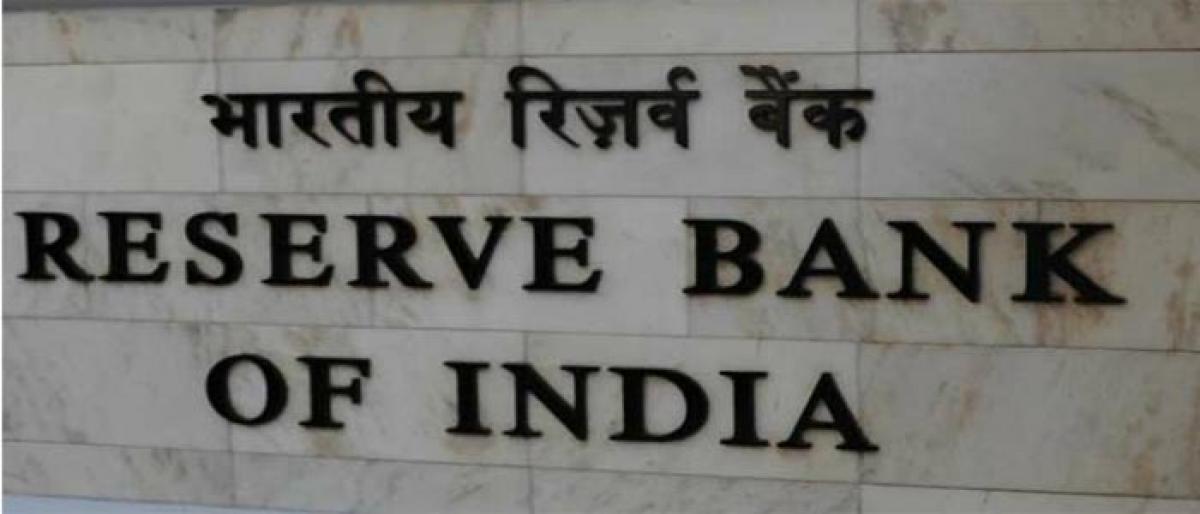Live
- Welfare hostels shut as bills pile up
- CM Revanth Reddy Slams BJP Leaders Over Inaction
- Minister Ponguleti visits Basara temple
- Ashutosh Gowariker to lead International Jury at IFFI 2024
- The global challenges of greener aviation
- Shreyas Media secures exclusive advertising rights for ‘MahaKumbh Mela 2025’
- Experience the journey of art
- Seven iconic ghats undergo makeover for Mahakumbh
- Smog engulfs capital with ‘severe’ air quality
- Slur against HDK wrong, Zameer will be corrected: K’taka Cong
Just In

The Reserve Bank of India (RBI) is expected to keep its key interest rate unchanged in its next monetary policy review on Wednesday, in view of the consumer price index (CPI) inflation in August shooting up to 3.36 per cent, according to latest official data.
Mumbai: The Reserve Bank of India (RBI) is expected to keep its key interest rate unchanged in its next monetary policy review on Wednesday, in view of the consumer price index (CPI) inflation in August shooting up to 3.36 per cent, according to latest official data.
While core inflation in August rose to 4.6 per cent, high food and fuel prices pushed wholesale inflation at 3.24 per cent, to nearly double of that over the previous month.
The RBI's monetary policy committee (MPC), which will deliberate over two days here from Tuesday to decide on the fourth policy review of the fiscal, has the mandate to target an annual retail inflation rate of 4 per cent, with a band of 2 per cent in either direction.
In the previous bi-monthly review in August, subdued inflation and demand had prompted the central bank to reduce its repurchase rate, or the short-term lending rate for commercial banks, by 25 basis points (bps) to 6 per cent from 6.25 per cent.
State-run State Bank of India (SBI), in a report titled "RBI caught in a bind: Expect status quo on October 4, 2017", said the apex bank faced a difficult decision on cutting its lending rate.
"On the eve of the forthcoming monetary and credit policy, the central bank is stuck in a conundrum of low growth, mild inflation, saving financialisation and external uncertainties. This will make the job difficult for the RBI on October 4," the SBI Ecowrap report said.
"The obvious question that arises is choosing between (a) the move towards the 4 per cent inflation target swiftly, or (b) staying in the inflation band," said SBI Chief Economic Adviser Soumya Kanti Ghosh.
"In hindsight, if the central bank moves towards the 4 per cent target in January 2018 as was suggested earlier, there would be limited room for rate cut in forthcoming policies."
The reduction in August came after four consecutive policy reviews in which the RBI had maintained status quo on its repo, or short-term lending rate, since the reduction by 25 bps to 6.25 per cent in October 2016.
Announcing the August review, the RBI said: "Noting, however, that the trajectory of inflation in the baseline projection is expected to rise from current lows, the MPC decided to keep the policy stance neutral and to watch incoming data. The MPC remains focused on its commitment to keeping headline inflation close to four per cent on a durable basis."
Domestic credit rating agency ICRA also discounted the possibility of an RBI rate cut.
"We do not expect a rate cut in the upcoming policy review as consumer price index (CPI) inflation is expected to chart an upward trajectory over the coming months, and print between 4.5 per cent and 5 per cent in March 2018," ICRA MD Naresh Takkar said in a report earlier this week.
Instead, the drop in GDP growth during the first quarter, has provoked strident Arate cut calls from industry, which wants urgent steps to revive private investments.
Pulled down by sluggish manufacturing, growth in the Indian economy, during April to June, fell to 5.7 per cent, clocking the lowest GDP growth rate under the Narendra Modi dispensation.
According to the American financial services firm Morgan Stanley, the RBI is expected to hold rates while maintaining its neutral policy stance.
"We expect the RBI to stay on hold at the upcoming meeting as rising incoming inflation and projections of further acceleration in inflation ahead will mean that there would be limited space for further easing," Morgan Stanley said in a research note.
The SBI report also pointed to external challenges like rising geopolitical tensions, and the hardening of commodity and crude oil prices. In mid-September, petrol rates here, for instance, Atouched their highest level since Modi assumed office three years ago.
"In particular, the external environment looks a little bit wobbly compared to what it was at the beginning of 2017," it said.
"No wonder, the rupee is currently witnessing depreciation pressures," the report added.
The rupee has recently come under pressure owing to volatile capital flows and the country's widening current account deficit.

© 2024 Hyderabad Media House Limited/The Hans India. All rights reserved. Powered by hocalwire.com







